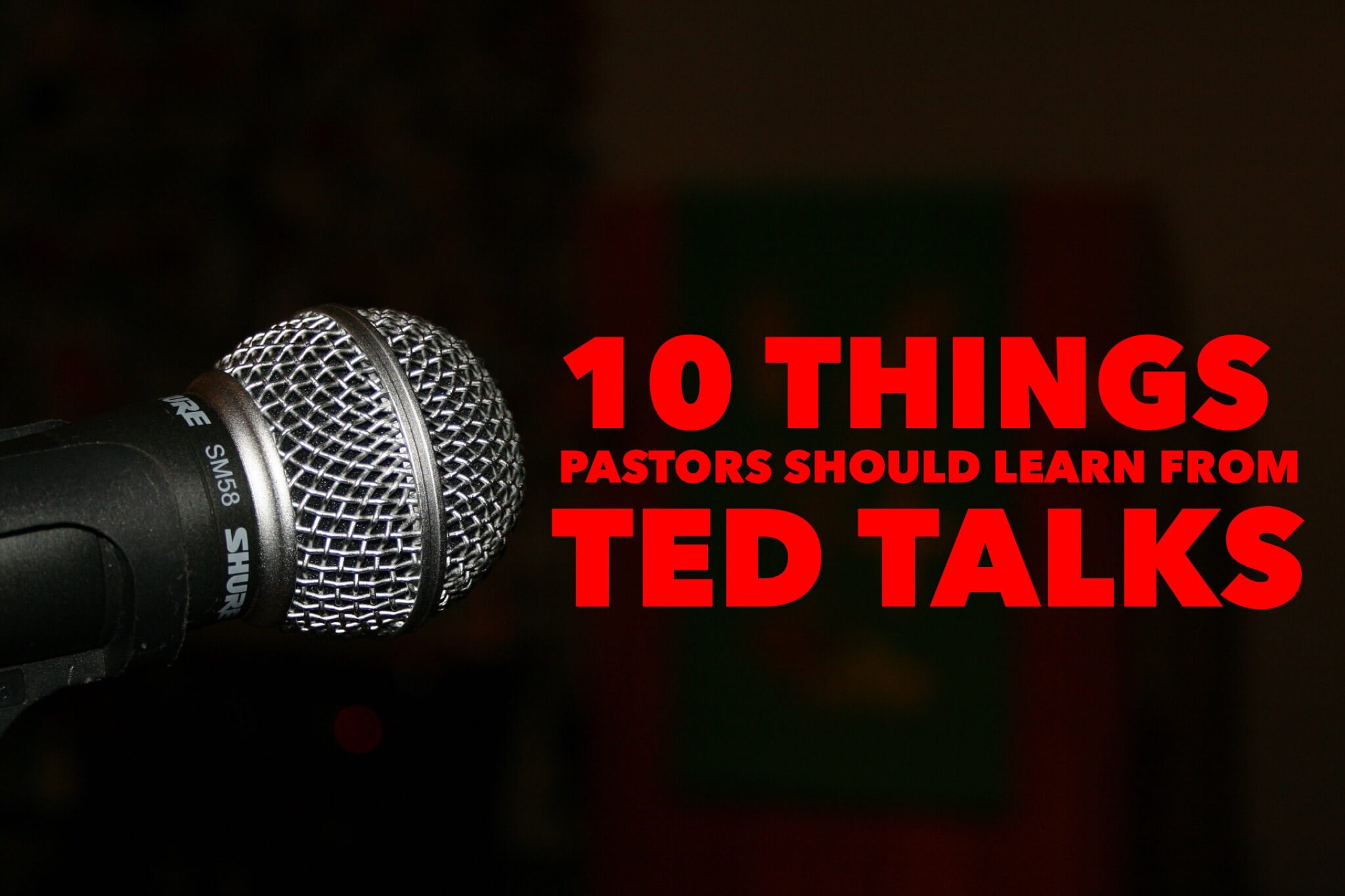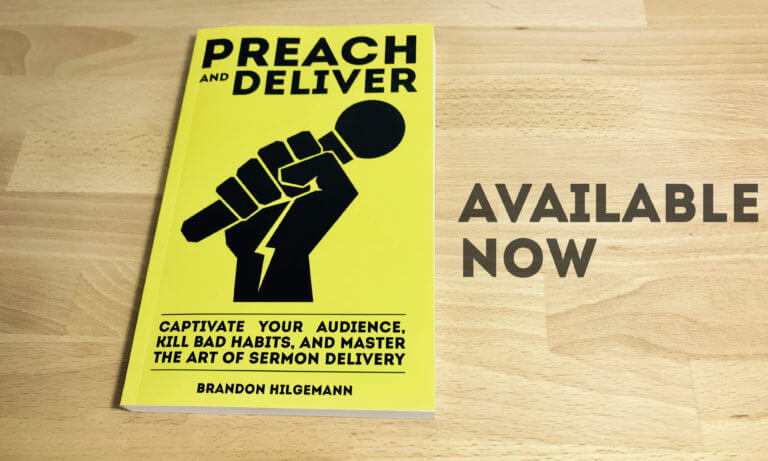10 Things Pastors Should Learn From TED Talks
Have you ever watched a really good TED talk?
Like this one, this one, or this one.
TED talks are some of the best presentations on the planet. The idea of a great TED talk becomes viral.
As pastors, I believe we communicate the most important “idea” ever. If we want to reach our culture, we can learn from these popular public speaking videos.
What makes these presentations engaging to our culture?
What can we apply to our preaching without compromising our message?
I have studied the TED talk guidelines for speakers, and here are some of the rules that the preachers could learn from.
10 Things Pastors Can Learn from TED Talks to Improve Their Preaching
1. Speak in 18 minutes or less.
Why is this important? Because most people in your audience are good at focusing on an idea for a small piece of time.
Sometimes less is more.
There is nobody in church on Sunday who thinks, “Oh boy, I hope the pastor preaches 15 minutes over his allotted time again today!”
Nobody ever said, “Bummer, church let out early today.”
Now, I understand that TED talks are different than sermons. 18 minutes is probably too short if you are unpacking a larger section of Scripture.
However, few preachers have the ability to preach over 30 minutes and keep their congregation engaged the entire time.
ACTION STEP: Cut 5-10 minutes off your sermon this week. You may find your sermon more focused for an even greater impact.
2. Communicate one idea effectively.
The best messages are laser-focused on a single idea.
How many times have you heard a pastor preach a sermon that contained enough ideas to be a whole series of sermons?
What is the one idea that God wants the key passage of Scripture you are preaching to say to your audience?
Unless closely tied to the main idea, if you have more than one point, your audience will miss the point.
ACTION STEP: Write one sentence that summarizes the point of your entire sermon. Preach only this point.
3. Start by making your audience care
Selfish as it sounds, the first things people in our audience are asking is, how does this help me?
If you don’t immediately show how your sermon will apply to your audience, they will begin to tune you out.
Why do they need to know what you are about to tell them?
How can this verse in the Bible change their life?
What questions do they have that this message will answer?
Care about your audience enough to help them care about your sermon.
ACTION STEP: Answer this question before writing your introduction: How will this message help my audience?
4. End by addressing how this idea could affect your audience.
In other words, cast the vision for your audience how the single truth of the day’s Scripture can radically change their life.
Conclude your sermon by casting the vision for what life could be if they applied the point of the message?
“Image what could happen if we all…”
“Imagine how your life would change if…”
“How would your family be different if…”
Help them leave inspired with a vision of something greater.
ACTION STEP: Answer this question before writing your conclusion: If someone believed this and acted on it what could happen?
5. Don’t use too much jargon or explain terminology.
If people need a theological dictionary to understand your sermon, you are not communicating clearly.
Drop the jargon. Translate the Christianese, and speak common English.
If you there is a word in the Bible verse that needs explanation, then please explain and move forward.
We cannot assume that most people even have a basic knowledge of the Bible anymore.
Nothing alienates a newcomer more than insider language.
ACTION STEP: Identify any Christian terminology in your message that needs explanation.
6. Help the audience remember a person, place or thing using images.
We live in a highly visual society.
Many people are more likely to remember things we see than things we hear.
Take advantage of this and use photos, images, or videos in your sermons as often possible.
Don’t go overboard. But if you quote or tell the story of a historical person, show a photo of them.
If you talk about a place in the Bible, show a picture of it today.
Don’t just tell; show and tell.
ACTION STEP: Identify any people, places, or things in your sermon that an image would help make more memorable.
7. Use as little text as possible in slides.
If your audience is reading, they are not listening.
TED talks tend to have great slides because they follow this principle.
Never have more than one point per slide.
Instead of bullet points, put each point on a different slide.
Sometimes a good photo says more than words.
ACTION STEP: Watch a few TED talks and study how they do slides. Then, make your sermon slides like this.
8. Rehearse, rehearse, rehearse.
If you want to deliver a world-class message every week, you have to prepare like a world-class speaker.
Running through your message one time in your head is not enough.
Never rehearsing your message, because you bring all your notes on stage with you won’t cut it.
Although most pastors do not have months to prepare their talks, like TED speakers do, that does not excuse us from practicing at all.
I cannot tell you how many times I wrote something that I thought was good, but sounded terrible when I said it out loud. Thank goodness I catch most of them when I practice.
ACTION STEP: Before you preach, rehearse your sermon at least three times.
9. Time yourself.
There is nothing worse than having only three more minutes to preach and thirty more minutes of content.
Know how much time you have to preach, and practice preaching within that time limit.
ACTION STEP: Time your message with a stopwatch while you practice so you know how long it takes.
10. No podiums.
This one might hit a nerve.
We pastors love our pulpits and podiums. But why doesn’t TED allow them?
Podiums disconnect the speaker from the audience.
There is a barrier between you and them.
Also, podiums are more formal.
ACTION STEP: Preach without a podium this week. You may be surprised how much more engaged your audience is.





Good stuff here to think about. How do you handle longer passages if the duration of preaching is short? Plain reading of the text as one walks through the verses itself will take a few minutes.
Thanks. Good question. Sometimes a longer passage requires a longer sermon. At other times it means a short introduction and then diving right into the passage. Sometimes I question whether or not an entire passage needs to be read, broken into multiple sermons, or summarized.